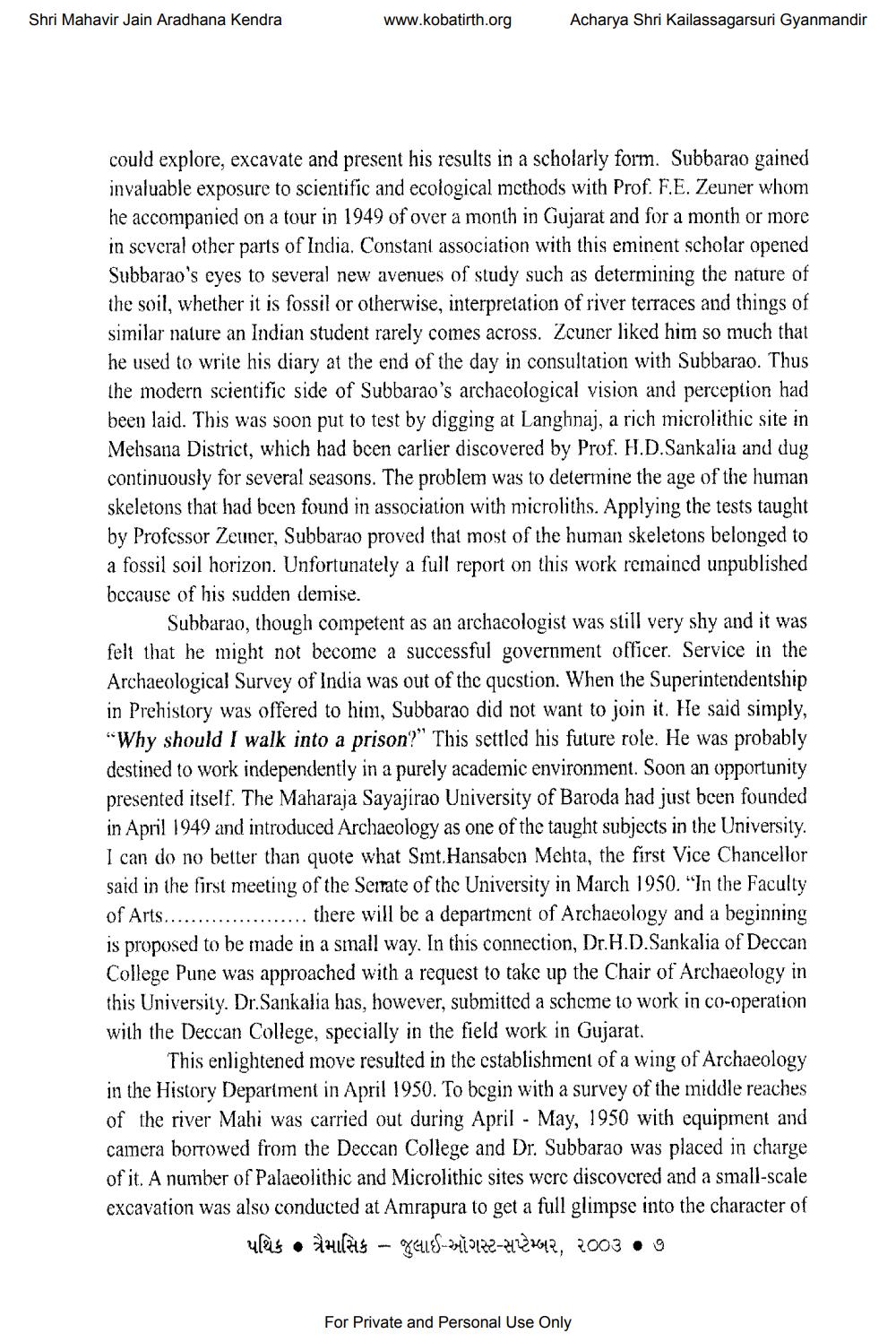________________
Shri Mahavir Jain Aradhana Kendra
www.kobatirth.org
Acharya Shri Kailassagarsuri Gyanmandir
could explore, excavate and present his results in a scholarly form. Subbarao gained invaluable exposure to scientific and ecological methods with Prof. F.E. Zeuner whom he accompanied on a tour in 1949 of over a month in Gujarat and for a month or more in several other parts of India. Constant association with this eminent scholar opened Subbarao's eyes to several new avenues of study such as determining the nature of the soil, whether it is fossil or otherwise, interpretation of river terraces and things of similar nature an Indian student rarely comes across. Zeuner liked him so much that he used to write his diary at the end of the day in consultation with Subbarao. Thus the modern scientific side of Subbarao's archaeological vision and perception had been laid. This was soon put to test by digging at Langhnaj, a rich microlithic site in Mehsana District, which had been earlier discovered by Prof. H.D.Sankalia and dug continuously for several seasons. The problem was to determine the age of the human skeletons that had been found in association with microliths. Applying the tests taught by Professor Zeuner, Subbarao proved that most of the human skeletons belonged to a fossil soil horizon. Unfortunately a full report on this work remained unpublished because of his sudden demise.
Subbarao, though competent as an archacologist was still very shy and it was felt that he might not become a successful government officer. Service in the Archaeological Survey of India was out of the question. When the Superintendentship in Prehistory was offered to him, Subbarao did not want to join it. He said simply, "Why should I walk into a prison?" This settled his future role. He was probably destined to work independently in a purely academic environment. Soon an opportunity presented itself. The Maharaja Sayajirao University of Baroda had just been founded in April 1949 and introduced Archaeology as one of the taught subjects in the University. I can do no better than quote what Smt.Hansaben Mehta, the first Vice Chancellor said in the first meeting of the Serrate of the University in March 1950. "In the Faculty of Arts... there will be a department of Archaeology and a beginning is proposed to be made in a small way. In this connection, Dr.H.D.Sankalia of Deccan College Pune was approached with a request to take up the Chair of Archaeology in this University. Dr.Sankalia has, however, submitted a scheme to work in co-operation with the Deccan College, specially in the field work in Gujarat.
This enlightened move resulted in the establishment of a wing of Archaeology in the History Department in April 1950. To begin with a survey of the middle reaches of the river Mahi was carried out during April - May, 1950 with equipment and camera borrowed from the Deccan College and Dr. Subbarao was placed in charge of it. A number of Palaeolithic and Microlithic sites were discovered and a small-scale excavation was also conducted at Amrapura to get a full glimpse into the character of
પથિક ♦ ત્રૈમાસિક ~ જુલાઈ-ઑગસ્ટ-સપ્ટેમ્બર, ૨૦૦૩ ૦ ૭
•
For Private and Personal Use Only




